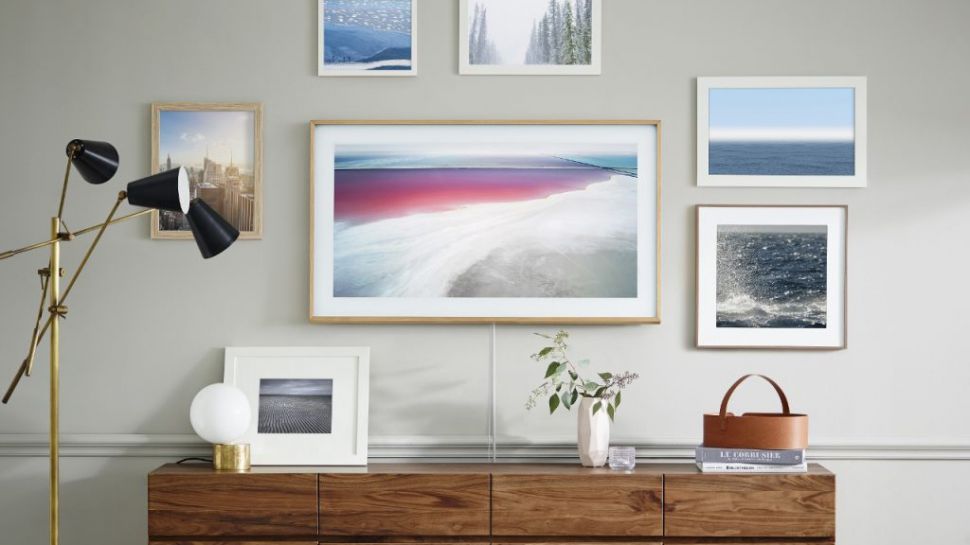Should TVs ever replace the art in our homes?
We ask whether the TV of the future should be bold, beautiful or hidden

Whether you’ve got yourself a fully-automated Jetsons house or just an Echo Dot and a few Hue bulbs, there’s no arguing that smart homes are well and truly mainstream nowadays.
As more and more connected tech enters your living room, the way it all looks and fits into your home needs to be taken into consideration more than ever. After all, there’s only so much real estate on your coffee table and only so many times you can look at an ugly, bulky device when a rival company is offering up a slick-looking, customisable one at the same price.
Although all kinds of smart tech gadgets will increasingly be designed with style in mind as much as substance, one obvious piece of tech that’s often aching for a makeover is the TV.
Although TV manufacturers have never been afraid to innovate, and names like Loewe and Bang and Olufsen have long been putting plenty of thought into the design and attractiveness of their screens, there’s potential for that huge space that takes up most of our living room walls to be turned into something more.
That’s why there’s been an increase in bigger, more mainstream tech companies over the past year or so revealing TVs and concepts that aren’t just smart and bursting with features, but are positioned more as a lifestyle statement, a front room centrepiece and, maybe, kinda, a piece of art.

Turning your TV into a work of art
One of the most obvious art-meets-tech collaborations was between Samsung and designer Yves Behar last year when they created The Frame. The Frame is a TV that spends half of its time as a TV and the other half of its time in Art Mode. That means when you’re not using it, it sits flush against your wall and displays photos or art.
Instead of using your TV to display art, a few brands have flipped the idea on its head and designed a TV that would look just as at home in a modern art gallery as it does in your, well, home. Take a look at the Bild X by Loewe, a TV that’s trying its hardest to look more like a piece of art than a tellybox with a round base, thin metal stand and no cables in sight.
Sign up for breaking news, reviews, opinion, top tech deals, and more.
Sometimes these nods to art are more subtle. Take LG’s OLED W8 which the company unveiled at CES 2018. LG calls the design aesthetic of the new TV ‘picture-on-wall’ and, put in front of a non-techy, it would definitely give the illusion of a beautiful art display. Maybe the future of TVs is moving to a more high-end and design-led aesthetic rather than going all out and mimicking it?
If it doesn't look incredible, let's make it invisible
Maybe we’re not thinking smart enough about the smart home. If TV tech can’t pass of as art, maybe the answer is to make it ‘invisible’ instead.
LG was busy at CES 2018 as it also unveiled a 65-inch TV concept that’s rollable, meaning you can roll it away when you’re done. That means there’s no more worrying about if it’ll compete with your art or look good in your room, instead you’ll just be able to get rid of it when you’re done.
Similarly, Panasonic has revealed details of its ‘Invisible TV’ at various trade shows over the years, a futuristic TV that turns into a regular old pane of glass when it’s not in use.

Of course designing a piece of tech that takes pride of place in your home as much as a TV is difficult because we all have different tastes. The same goes for what really constitutes ‘art’.
For instance, a TV that looks like it belongs in MoMA is unlikely to look at home next to my two Billy bookcases. Yet in some houses space constraints will dictate whether you buy a big TV or purchase one in the not-so-distant future that promises to remain hidden.
But these choices are what's important. As more people add tech into their homes and decide how they want it to look, the choice to choose between form, function or big, bold statement is one that should be welcomed.
- Our guide to the best TVs contains our top picks for this year

Becca is a contributor to TechRadar, a freelance journalist and author. She’s been writing about consumer tech and popular science for more than ten years, covering all kinds of topics, including why robots have eyes and whether we’ll experience the overview effect one day. She’s particularly interested in VR/AR, wearables, digital health, space tech and chatting to experts and academics about the future. She’s contributed to TechRadar, T3, Wired, New Scientist, The Guardian, Inverse and many more. Her first book, Screen Time, came out in January 2021 with Bonnier Books. She loves science-fiction, brutalist architecture, and spending too much time floating through space in virtual reality.